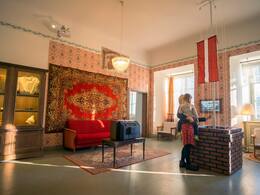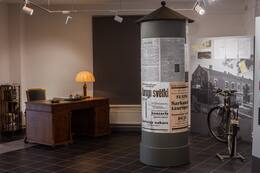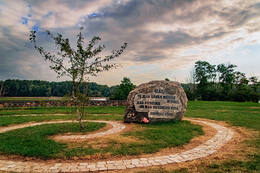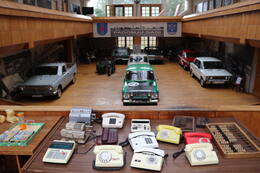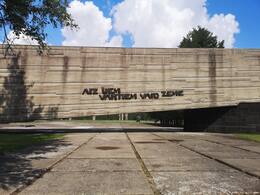The Great Cross-Border Route – Military Heritage of Latvia and Lithuania in 100 Years
Day 6.
240 km
Daugavpils - Jēkabpils - Pļaviņas - Salaspils - Rīga
Practical info
- Maršruts ir domāts kā padomdevējs - kā optimālāk apceļot reģionu vai valsti, vai divas valstis ar mērķi iepazīt to militāro mantojumu;
- Braucējam pašam ir jāizplāno – cik no ieteiktajiem objektiem un vietām viņš vienas dienas laikā var iepazīt;
- Pirms ceļojuma ir jānoskaidro apskates vietu (muzeju, kolekciju, fortifikācijas u.c. objektu) darba laiks;
- Vietās, kur ir iepriekšēja pieteikšanās (vietējie gidi, privātas kolekcijas, cits), ir jāpiesaka vizīte, norādot datumu un laiku. Ja ceļojums tiek atcelts, ir jāinformē pieteiktās vietas;
- Naktsmītnes ir jārezervē laicīgi. Vasaras sezonā, īpaši jūras piekrastē naktsmītnes var būt nepieejamas. Daļa no ēdināšanas uzņēmumiem ziemas sezonā var nestrādāt;
- Ceļojumam izvēlieties ne tikai vasaru, bet arī citus gadalaikus;
- Latvijas – Lietuvas – Igaunijas robežas pa autoceļiem var šķērsot brīvi bez ierobežojumiem un jebkurā diennakts laikā. Iebraucot no vienas valsts otrā ir jābūt līdzi ID kartei vai pasei;
- Apmeklējiet tūrisma informācijas centrus, kur var iegūt papildus informāciju, bukletus, kartes.
Sights
Daugavpils Fortress
The Daugavpils Fortress is located on the right bank of Daugava, in the western part of the city of Daugavpils. This is the only fortress of the first half of the 19th century in Northern Europe, which has survived almost unchanged. Construction began in 1810, shortly after which it suffered in the war of 1812 and the floods of 1829. The fortress was a place of strategic importance, including in the fight against Napoleon’s army. Consecrated in 1833, the fortress was completed almost half a century later, in 1878. The Daugavpils Fortress is divided into quarters, with the Parade Square located in the central part. Later the fortress lost its strategic importance and a warehouse was set up in it in 1897. Before World War I, Latvian Army officers, including General Jānis Balodis and Colonel Frīdrihs Briedis, served in the Daugavpils Garrison. In honour of the centenary of the war of 1812, a monument was unveiled in the fortress park in 1912. Army units were stationed here during the Soviet era, and the Daugavpils Higher Military Aviation Engineering School was established. The fortress features several tourist attractions, including the Daugavpils Fortress Culture and Information Centre (trips around the Daugavpils Fortress are available), World War I Museum, Daugavpils Mark Rothko Art Centre, the White Horse art gallery, a medical exhibit displaying contraceptives, the Housevintage antique shop, the Daugavpils Bat Centre and the ‘Retrogaraž-D’ exhibit of retro cars.
Jersika National Partisan Hiking Route
A hard-to-find natural object. Hike length: approximately 22 km, can be completed in approximately 6 hours.
Hike length: approximately 22 km, can be completed in 6 hours.
Difficulty level: medium fitness hike.
Starting point: Jersika Elementary School (can be reached by train, bus).
End point: Vanagu Church (public transport does not run on weekends).
Note: The route includes a swimming break (during the summer season), fishing opportunities, a picnic area, and one public toilet. The route is also suitable for school-age children who already have experience in hiking of this length.
Go on a hike from Jersika to Vanagi, allowing yourself to be challenged in endurance, as the hike leads through forests, swamps, moors, meadows and country paths, and in the historical knowledge of the most prominent figures of the national partisan movement, their activities, see the most significant places about which local legends and written memories of fellow citizens are told. The path begins at the Jersika elementary school and leads to a memorial stone under an old oak tree, further along the way including the Jersika railway station. The inscription on the stone reads “LTS(p)A – For the fighters of the Latvian Fatherland Partisan Association. LTS(p)A united the national partisans of six Latvian districts in the fight against the communist occupation regime in 1945-1955”.
The walk continues along the railway tracks and winds along Lake Jersika, where the forest presents natural treasures: spring-flowering primroses and common sedge. The smell of primroses indicates that you are approaching the bog, but in spring it is especially surprising to see them blooming. A lazy walk is not possible, several ditches must be overcome, crossing the bog provides a tempering - water remains in the moss at every step, cranberry berries shine in the bushes. The bog is replaced by a forest and evidence of the former settlement of these places in homesteads - stately oaks, ruins of buildings, the site of a national partisan bunker surrounded by young growth. The path continues to the place mentioned in the testimonies as the place of founding of the Fatherland Guards (partisans) association. The forest massif also hides the memorial site “Avotnīca” (“Olūtneica”), where a campfire has been set up. The diversity of the forest is surprising, as is the width of the ditches. The destination of the hike is Vanagi Church, where priest A. Juhņevičs served, and about whom the film “Segvārds Vientulis” (directed by N. Pucis) tells the story.
Exhibition "Struggles for freedom in the 20th century" in Jēkabpils History Museum
Located in Krustpils Palace
Viewable exhibition "Fights for freedom in the 20th century"
Soviet repression. Hard memories. Sitting here in a club chair, you can listen to fragments of the book "Those were the times" by Ilmars Knaģ from Jēkabpils. On one of the walls of the room, a list of townspeople deported to Siberia slides dispassionately, like the credits after a movie. There you can watch an amateur video about the removal of the Lenin monument in Jēkabpils on the old TV. Visitors are interested not only in the content, but also in the technical possibilities - how did this film get on the old TV.
It is possible to listen to the lectures prepared by the museum specialists at the Jēkabpils History Museum or apply for an excursion: Jēkabpils and its surroundings in the First World War, Jēkabpils in 1990, the time of the Barricades, the deportations of 1949 - 70, Jēkabpilians Cavaliers of the Lāčplēš Military Order, etc.
The average duration of lectures is 40 min. Information and registration for lectures by calling 65221042, 27008136.
Jēkabpils History Museum is located in Krustpils Castle. In 1940, after the inclusion of Latvia in the USSR, the 126th Rifle Division was stationed in Krustpils Castle. During the Second World War, the castle housed a German infirmary, and after August 1944, a Red Army war hospital. After the war, Krustpils Castle with the adjacent manor buildings were occupied by the central warehouses of the 16th Long-range Reconnaissance Aviation Regiment and the 15th Air Army of the Soviet Army.
Exposition "Latvian Army in Pļaviņas in the 20th Century"
Located at Odzienas Street 2, Pļaviņas.
The permanent exposition "Latvian Army in Pļaviņas in the 20th Century" can be seen.
The building in Pļaviņas, Odzienas Street 2, has a long history - from the time when Stukmaņi wholesaler Hugo Apeltofts started active economic activity in it, thus promoting the development of Pļaviņas city, until the headquarters of the Latvian Eastern Front was established here during the War of Independence. In 1919, the activities of Latvian army units against the Red Army in Latgale were commanded directly from Pļaviņas.
In 1934, a memorial plaque was unveiled near this house with the inscription: "In 1919, the headquarters of the Eastern Front was located in this house, and here General Jānis Balodis took over the command of the Latvian National Army." It was removed and destroyed by the Soviets in 1940, but on June 16, 1990, with the support of the LNNK Plavinas branch, it was restored.
Now, next to the former headquarters building, there is a memorial stall dedicated to 15 cavalry of the Lāčplēsis Military Order born in Pļaviņas region. In Pļaviņas, as well as provides an insight into the life stories of the Knights of the Lāčplēsis War Order.
Not far from the exposition building is the Latgale Division headquarters building, which was built in 1913 by Count Teodors Medems as a Stukmaņi liqueur factory. In 1919 it was taken over by the regime of P. Stučka, where it had also established a prison. After the expulsion of the Bolsheviks, in 1925 the building was taken over by the Latvian Army, which housed the headquarters of the Latgale Division. 10 generals and other officers of the Latvian Army spent their military careers in this building. In 1940, the building was taken over by the Red Army. In the post-war years, it housed a school as well as a municipality. Around 1970, the building was started to be used by the production association "Rīgas Apīrsbs".
Visits to the exhibition must be booked in advance by calling T. 28442692.
A memorial dedicated to the mothers of Siberia in the "Garden of Destiny"
Located on an island in Koknese parish.
The Garden of Destiny is a symbol created in nature for the constant renewal and growth of the nation – the past, present, and future of both the person and the country meet here. Similar to the Freedom Monument, the Garden of Destiny is also created thanks to donations.
In collaboration with the Latvian Association of the Politically Repressed, a memorial ensemble for the mothers of Siberian children has been created at the center of the virtual House of Silence. Two boulders, engraved with the words “Mother, you gave me life twice. When I was born and when I did not die of hunger. A child of Siberia,” remind us of their selflessness and great sacrifice.
The territory of the Likteņdārzs preserves World War I trenches. A memorial site has been created for the Latvian riflemen in them, which was unveiled on the 100th anniversary of the founding of the riflemen regiments. The composition of the site consists of two parts: a group of Latvian boulders symbolizes those who stayed home, and a row of boulders placed in the World War I trenches symbolizes the Latvian riflemen. The stones were selected and artistically arranged by sculptor Ojārs Feldbergs.
Aizkraukle museum of History and Art, exposition "Soviet years"
The exhibit is located in the former culture house of Aizkraukle parish. It reflects the everyday social, recreational, professional, educational and cultural life in Soviet times, as well as the history of how Aizkraukle (during Soviet times – Stučka) and the Pļaviņu HPP came to be. Visitors can view the ‘Red Corner’ with its historical propaganda materials, the office of a party functionary and a typical Soviet apartment with a living room, kitchen, bathroom and toilet and their corresponding attributes. Some rooms are dedicated to Soviet medicine, tourism and sports as well as repression tactics. There is a spacious hall in the centre of the exhibit for Soviet-made vehicles. This was started in 2016 by the Aizkraukle History and Art Museum by setting up the exhibit on three floors. Nowadays it is the largest exhibit in the Baltics dedicated to this period of Soviet occupation.
Salaspils Memorial Ensemble
Salaspils Memorial and historical exhibit is located in Salaspils municipality, 1.2 km from the Riga-Daugavpils A6 highway. The Salaspils Memorial was unveiled in 1967 on the site where during World War II the Salaspils Camp was once located. It is a place that was used for Soviet propaganda and is shrouded in myths and half-truths. It is a good representation of the Nazi crimes and Communist ideology that was carried out during each of the occupations. This repressive camp was a part of the German penitentiary system. It had similarities with concentration camps, but it was not the same thing. It was created so that there would not be a disproportionate number of prisoners in Riga prisons. This camp was an “extension of the police prison”. And a variety of people were imprisoned here – Jews, the Red Army prisoners of war, absentees, political prisoners, criminals, prostitutes, members of the Latvian resistance movement, Baltic soldiers in the German Army or police, and others. The camp could hold up to 2,200 prisoners. The main cause of death (~2000) was malnutrition, working conditions, corporal punishment and illness.
Places to eat
- Daugavpilī sk. visitdaugavpils.lv
- Restorāns "Kalnakrogs", Līvānos, https://www.celotajs.lv/lv/e/kalnakrogs
- Jēkabpilī, sk. visit.jekabpils.lv
- Pļaviņās un Aizkrauklē, sk. visitaizkraukle.lv
- Restorāns "Rudolphs", Koknese, https://www.celotajs.lv/lv/e/rudolfs
- Ogrē, sk. visitogre.lv
Places to stay
- Daugavpilī sk. visitdaugavpils.lv
- Jēkabpilī, sk. visit.jekabpils.lv
- Pļaviņās un Aizkrauklē, sk. visitaizkraukle.lv
- Viesnīca "Small Dune", Koknese, https://www.celotajs.lv/lv/e/mazakapa
- Ogrē, sk. visitogre.lv






